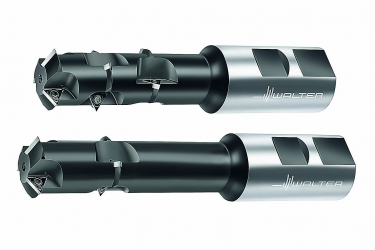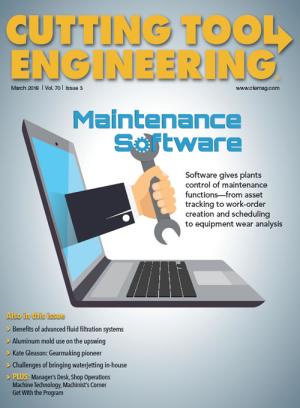It’s been less than 2 years since Walter USA LLC launched its cutter family for milling large threads, the T2711/T2712 system. Now, with its release of new tool bodies and inserts, Walter significantly expands the system, combining the advantages of thread milling and tapping.
When the T2711/T2712 was introduced in 2016, its biggest advantage was insert design, according to Walter Product Manager Luke Pollock. “By causing the chip to curl inwards, away from the part, it is a very smooth-cutting tool, keeping cutting forces to a minimum.”
Pollock said the design allows threads to be cut in one pass, eliminating the need for multiple passes or running a spring pass to ensure that the thread pitch is within specification.

Walter’s T2711 (top) and T2712 combine the advantages of thread milling and tapping. Image courtesy of Walter USA.
The original system offered nine tool bodies for M and MF thread styles, with metric-dimensioned shanks. For UNC/UNF/UN threads, there were three tool bodies with metric shanks and three with inch shanks. The original system offered five different combinations of insert size and corner radius, so a large number of thread sizes and pitches could be produced.
The company’s new products include two new tool bodies for producing M56 and M64 coarse-pitch threads. With these additions, users can cut essentially any pitch from 6 to 18 tpi (1.5mm to 6mm).
In addition, Walter has introduced three thread milling inserts. Their smaller corner radii reportedly expand the system’s versatility. As a result, users can cut finer pitches. Furthermore, when row spacing is an integral multiple of the pitch, the multiple-row bodies can cut multiple pitches rather than just one or two.
Pollock said there tends to be more tool bodies with the metric program than with the inch one. Metric tools generally are not as versatile because of the definition of the thread pitch, which affects the spacing of threads. Walter has designed the tool bodies so that not as many are needed with UNC/UNF/UN tools.
“By simply modifying the insert design slightly—i.e., changing the corner radius—multiple thread pitches can be machined with the same tool body,” Pollock said.
The new products are independent of each other and cover different-size thread pitches. Pollock pointed out, however, that the inserts have been standardized, providing the advantage of using one system, even if multiple tool bodies are required. “Our goal,” he said, “is to produce as many different threads as possible with a single tool.”
For more information about Walter USA LLC, Waukesha, Wis., visit www.walter-tools.com/us or call (800) 945-5554.
Contact Details
Related Glossary Terms
- gang cutting ( milling)
gang cutting ( milling)
Machining with several cutters mounted on a single arbor, generally for simultaneous cutting.
- milling
milling
Machining operation in which metal or other material is removed by applying power to a rotating cutter. In vertical milling, the cutting tool is mounted vertically on the spindle. In horizontal milling, the cutting tool is mounted horizontally, either directly on the spindle or on an arbor. Horizontal milling is further broken down into conventional milling, where the cutter rotates opposite the direction of feed, or “up” into the workpiece; and climb milling, where the cutter rotates in the direction of feed, or “down” into the workpiece. Milling operations include plane or surface milling, endmilling, facemilling, angle milling, form milling and profiling.
- pitch
pitch
1. On a saw blade, the number of teeth per inch. 2. In threading, the number of threads per inch.
- tapping
tapping
Machining operation in which a tap, with teeth on its periphery, cuts internal threads in a predrilled hole having a smaller diameter than the tap diameter. Threads are formed by a combined rotary and axial-relative motion between tap and workpiece. See tap.



